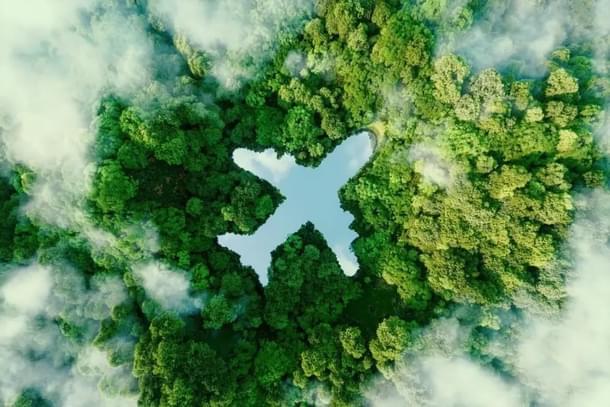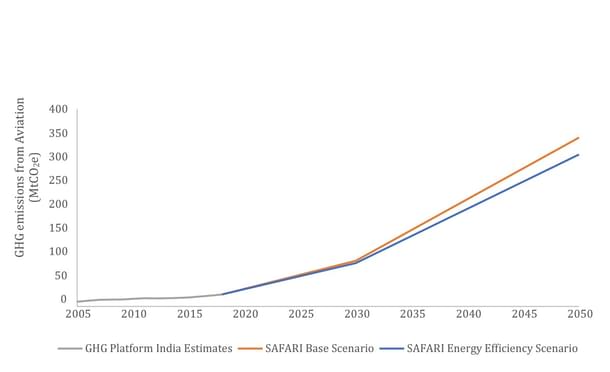Infrastructure
Finding Opportunities In Challenges: How India Can Spearhead A Global Drive For Decarbonising Aviation
V Bhagya Subhashini
Aug 01, 2023, 02:15 PM | Updated 02:15 PM IST
Save & read from anywhere!
Bookmark stories for easy access on any device or the Swarajya app.


The aviation industry has revolutionised global connectivity, trade, and travel, becoming an indispensable part of modern society.
However, this rapid growth has come at a significant environmental cost, with aviation being a major contributor to greenhouse gas emissions.
As the world grapples with the challenges of climate change, the urgency to decarbonise aviation becomes more pressing than ever.
Sky-High Emissions: The Environmental Toll of Aviation
Aviation is one of the fastest-growing contributors to greenhouse gas (GHG) emissions, fuelling global climate change. It accounts for 2-3 per cent of global CO2 emissions annually.
If the aviation industry as a whole were a country, it would be among the world's top 10 carbon-polluting nations. A return flight from London to New York emits more carbon emissions than the average person in 56 countries would produce in an entire year.
India's Aviation Boom And Environmental Impact
India has emerged as the world's third-largest aviation market after the US and China, due to the increase of low-cost airlines, infrastructural development, rising disposable income, and the expansion of the tourism industry.
Domestic and international air passenger traffic in India is estimated to exceed 395 million in 2023-24. Domestic airport passenger counts in India are expected to exceed 700 million by FY2030, while international airport passenger numbers would reach 160 million.
Aviation turbine fuel (ATF), a primary fuel utilised in the aviation industry, is a petroleum refinery byproduct.
GHG emissions from the Indian aviation sector have increased by 2.5 times (25 million tonnes of CO2 equivalent since 2005), with a compound annual growth rate of 7.34 per cent.
According to the Sustainable Alternative Futures for India (SAFARI) model established at the Centre for the Study of Science, Technology, and Policy, the number of aircraft passengers might increase fourfold by 2030 and fifteen-fold by 2050 when compared to 2018 levels.
According to the SAFARI model, GHG emissions from aviation transport (including freight) will grow by 3.6-3.8 times by 2030 and 12.6-14 times by 2050 compared to 2018.

Sustainable Aviation: A Multifaceted Approach
Sustainable aviation is not a one-size-fits-all solution; rather, it requires a holistic and multifaceted approach to address the industry's environmental footprint comprehensively.
Embracing technological advancements, operational efficiencies, and alternative fuels are key components of this approach. To achieve genuine sustainability, every stage of an aircraft's lifecycle, from production to disposal, must be considered.
Low-Carbon Propulsion Technologies: The Promise And Limitations
Electric Aircraft: Electric aircraft hold great promise for zero tailpipe emissions and reducing carbon footprints. However, weight limitations and limited range pose significant challenges for long-haul flights.
Further research and development are needed to enhance battery technology and commercial viability for electric aviation.
Hydrogen-Powered Aircraft: Hydrogen-powered aircraft also present a potential low-carbon propulsion technology. While they offer cleaner emissions, current hydrogen technology is not suitable for long-haul flights.
Substantial research and development efforts are required to make hydrogen-powered aviation commercially viable.
Sustainable Aviation Fuels: A Step Towards Cleaner Skies
Sustainable aviation fuels (SAF) are considered one of the most viable alternatives to traditional jet fuels. Derived from sources such as agricultural waste and carbon capture, SAF is compatible with existing aircraft and infrastructure.
However, limited production capacity and higher costs compared to conventional fuels have hindered widespread adoption.
Global Best Practices In Decarbonisation
United Kingdom (UK): The UK has taken proactive measures to decarbonise its aviation sector, including strategies such as air space modernisation and influencing consumer behaviour.
By incorporating international aviation emissions into its carbon budget, the UK demonstrates a commitment to align with the Paris Agreement's temperature goals.
United States (US): The US is focused on aircraft and technology upgrades, as well as extensive research in battery-powered and hydrogen fuel cell aircraft. Their dedicated Aviation Climate Action Plan outlines a comprehensive approach to achieve sectoral net zero by 2050.
Europe: Some European nations have taken significant steps to reduce aviation emissions. France and Austria have implemented bans on short-haul flights where an equivalent train ride is available, promoting more sustainable travel alternatives.
India's Aviation Sector: Challenges And Opportunities
India will be part of the Carbon Offsetting and Reduction Scheme for International Aviation (CORSIA), with the offsetting requirements expected to be applicable for India from 2027 onwards.
Airlines flying in India have also started following stringent efficiency measures and updating their fleet with state-of-art technologies and more fuel-efficient engines.
Since 2019, the Indira Gandhi International Airport, Delhi, has been using TaxiBot, a semi- robotic hybrid special purpose vehicle for aircraft taxiing, which has helped airlines save 2.1 lakh litres of ATF as of 2021.
With regard to the adoption of low-carbon fuels in the Indian aviation sector, some airlines have already used blended ATF–SAF in demo flights.
The Indian Institute of Petroleum under the Council of Scientific and Industrial Research (CSIR, CSIR-IIP) has established a pilot plant for SAF production at Dehradun for flight tests by the Indian Air Force. The maiden biofuel flight in the country by SpiceJet was also fuelled by the CSIR-IIP production facility.
Recently, CSIR-IIP, SpiceJet, and Boeing have joined hands to explore opportunities for the use of SAF in the Indian aviation industry. CSIR-IIP is also currently awaiting ASTM certification for the commercial production of SAF at a capacity of 15,000 litres per day (approximately 3,200 tonnes annually).
The recent amendment (May 2022) in the National Policy on Biofuels 2018 allows more feedstocks for biofuels and the promotion of biofuel production in India under the ‘Make in India’ Programme, enabling India to be well-positioned in SAF production.
Roadmap For Net-Zero Aviation In India
Decarbonisation of the Indian aviation sector by 2050 requires a combination of strategies including fleet renewal with efficient flights, operational improvements in ATM, and the use of a SAF–ATF blend.
In addition, the wide adoption of TaxiBots to cater to air-taxiing at Indian airports would considerably reduce GHG emissions.
Meanwhile, research in electrification and hydrogen fuel to develop solutions for aviation is needed. Adequate support should be provided by the government to encourage research and pilot studies on SAF production processes and various domestically available feedstocks.
Indian airlines have maintained a good track record in reducing ATF consumption through the use of a more energy-efficient fleet.
Seeking international collaborations and learnings from global best practices will aid in reducing inefficiencies in the current Air Traffic Management (ATM) system in the Indian aviation sector.
Considering costs, technology maturity, and feedstock, hydro-processing and alcohol-to-jet fuel methods are viable approaches for the mass production of SAF to ensure wide-scale deployment in India.
The major feedstocks can include used cooking oil, animal fats, and other oils as well as agricultural residues such as straw, husks, chaffs, and surplus sugar molasses.
Furthermore, India needs to develop plans to achieve an SAF–ATF blend target of 1.2 per cent (including passenger and freight) by 2030.
This is in line with the voluntary targets of transporting 100 million domestic passengers in India on a 10 per cent blend of SAF by 2030 set under the Clean Skies for Tomorrow Initiative. It is a coalition across the aviation sector wherein many Indian airlines, airports, and institutes participate to facilitate the net-zero transition.
Challenges Ahead: Clearing The Path To Sustainability
ATM System Improvements: As air traffic demand increases, maintaining and improving the efficiency of the air traffic management system will be challenging. Continued investment in infrastructure is vital to minimise fuel burn per flight.
Raw Material Supply for SAF: While India has sufficient feedstocks for SAF production, there is a lack of efficient collection, segregation, and supply mechanisms. Sustainable cultivation practices must be adopted to avoid adverse environmental impacts.
Cost of SAF: The higher cost of SAF compared to conventional fuel is a major barrier to its widespread adoption. Policy interventions and commercial deployment support are needed to reduce production costs and make SAF economically viable.
Procedural Delays for SAF Production: The lengthy certification and approval process for SAF production can hamper scaling up production capacity. Streamlining these procedures will be essential in meeting ambitious blending targets.
Summing Up
Decarbonising aviation is an urgent imperative for a sustainable future. As aviation continues to play a crucial role in global connectivity and economic growth, it must also take responsibility for its environmental impact.
Through collaborative efforts, technological innovation, and forward-thinking policies, the aviation industry can pave the way towards a greener and cleaner future.
By embracing sustainable practices and making conscious choices, the skies can be cleared for a more environmentally responsible aviation sector. Only then can we ensure that the wings of progress carry us towards a sustainable future for generations to come.
V Bhagya Subhashini is a staff writer at Swarajya. She tracks infrastructure developments.





